Turkey, now known as Turkiye, is a superb country for your next trip. It is modern and diverse! It is especially known for its beautiful beaches, mind-blowing history, stunning architecture (Greco-Roman and Ottoman), incredible landscapes, pretty towns, and hospitable people. This Turkey travel guide will take you through everything you need to know before your visit so you can plan your Turkiye trip better!
1. Know the country
OFFICIAL NAME: Republic of Turkiye
CAPITAL: Ankara (no, it is not Istanbul)
LOCATION: It is a transcontinental country located mainly in Asia and partly in Europe
OFFICIAL LANGUAGE: Turkish – script is in the Latin alphabet like English.
RELIGION: Turkey is a secular state with no official religion. However, the majority practise Islam.
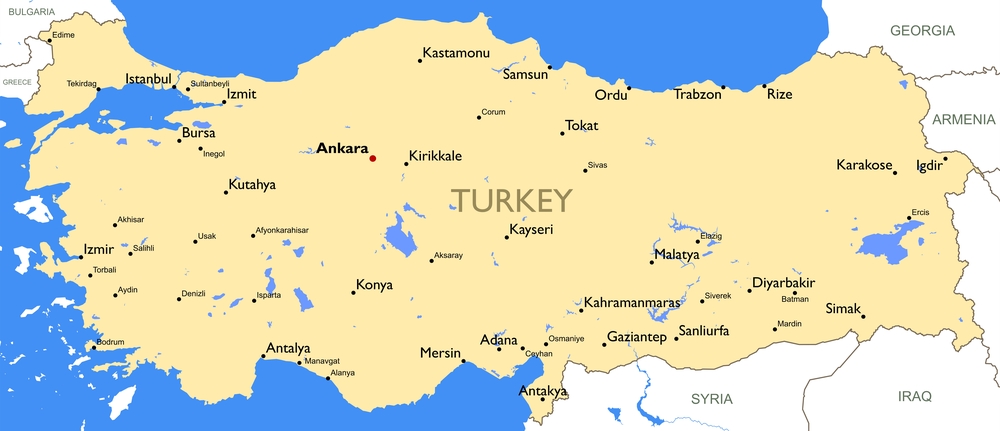
2. The Best months to Visit Turkey
| Months | Season |
| December – March | Cool to freezing: Best to avoid |
| April-May | Pleasant: Best time to visit |
| June – August | Warm to scorching and crowded: Best to avoid |
| September – November | Pleasant: Another good time to visit |
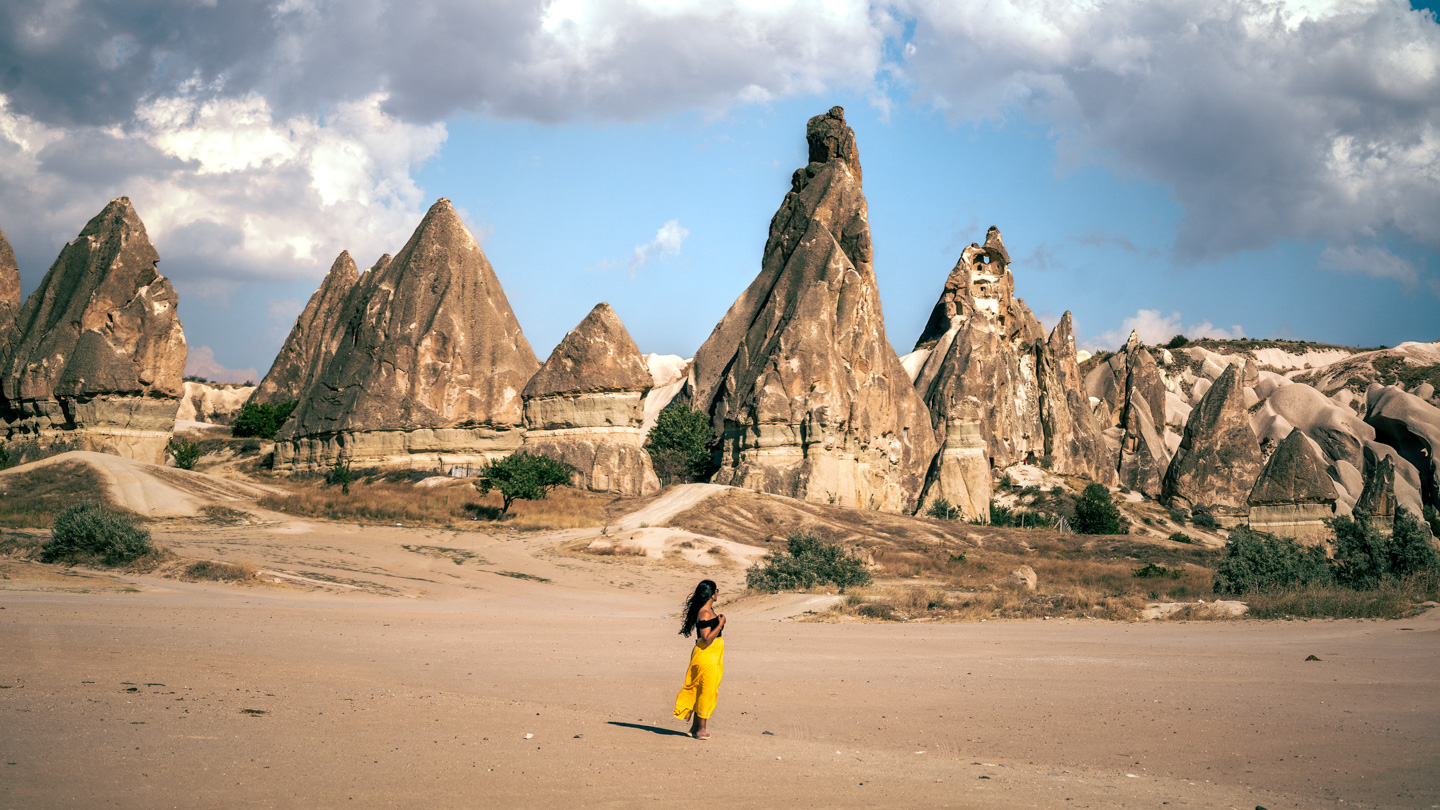
December – March: During this time, it is quite cold in the country with the exception of southeast Turkey (Antalya and surrounds). Most hotels and restaurants in a lot of beach towns will be closed. Snow is not uncommon, especially in Cappadocia and Konya. While snow creates a fantastic landscape in Cappadocia, hot air balloon flights are cancelled more often. That said, there will be less crowd at tourist sites making it a fantastic time to visit places like Istanbul – as long as you can deal with a bit of rain and snow. Your Turkey trip will be the cheapest during this time!
June-August: The summer months are very hot with temperatures going above 30°C. This is perfect for lounging by the sea or a pool but sightseeing can be unbearable. We went in August and experienced this firsthand -must’ve had a million lemonades to stay cool. Even though it’s so hot, there are a lot of visitors because Europeans come in droves during the summer months. Hence, this season is categorized as peak season and prices soar! If you do visit during this time, try and stay indoors during the afternoon.
March to May and September-November: Though this entire period is generally pleasant, I’d say April and late October are the best times to visit because it’s the perfect balance between weather and crowd.
3. How many days are enough for a Turkiye trip
You should go on at least a 10-day trip to Turkey – the more the better because there is so much to see. A lot of people visit for 2-3 weeks and still don’t get bored. But since that is not possible for most, 7 days is the minimum we would suggest.
4. PLACES TO VISIT IN TURKEY
Turkey has a lot of fantastic destinations, however, we will just cover a few of the most popular places to visit here.
1. Istanbul – city life, history, culture, shopping, food
Istanbul is a bustling city lying on two continents ( Asia and Europe) where the old and new exist beautifully side by side. Since, Istanbul is such a historic city that was the capital of two dynasties – the Eastern Roman Empire and the Ottoman – there are a lot of things to see and do like mosques, palaces, museums, cruises, Hamam Spa, nightlife, and shopping. You could easily spend a week or more here but we’d recommend a minimum of 2-3 days.
Closest Airports: Sabiha Gökçen International Airport (Asian Side) and Istanbul International Airport (European side)
Hotel Options: Mest Hotel Istanbul (great view), Romance Hotel (well-rated mid-range hotel), Hostel Le Banc (hostel in Beyoglu)
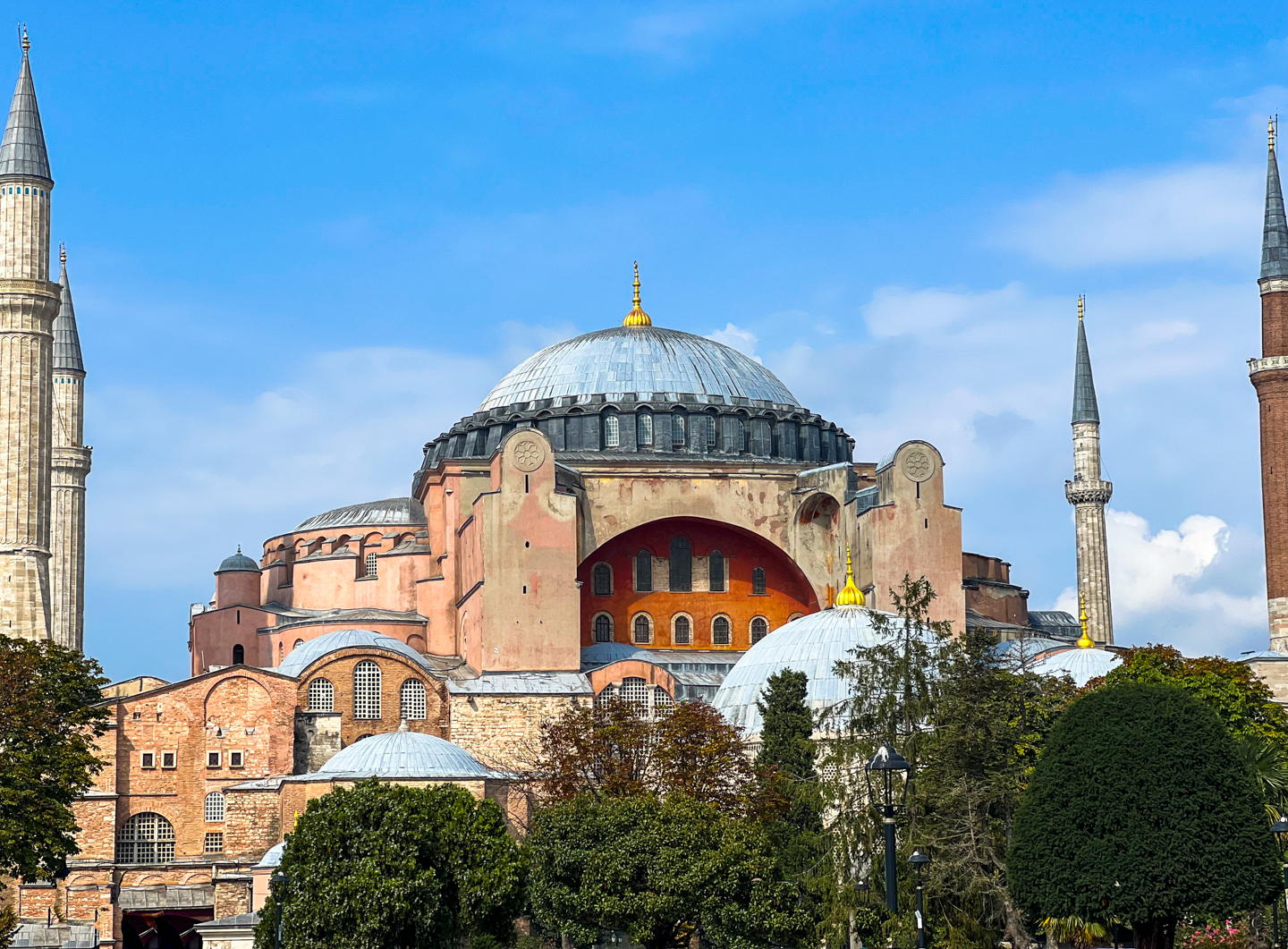
2. Cappadocia – landscapes, cave stay, hot air balloons
Cappadocia is home to a surreal landscape made of volcanic stone and cave hotels. However, hot air balloon rides are the most popular thing to do. You’ll need at least 2-3 mornings in Cappadocia if you wish to ride on a hot air balloon. For more info, read the complete list of tips for a dreamy hot air balloon ride in Cappadocia.
Closest Airpots: Kayseri Airport and Nevşehir Kapadokya Airport
Hotel Options: Arinna Cappadocia (luxury), Local Cave Hotel (mid-range), The Dorm Cave By Travellers (hostel)
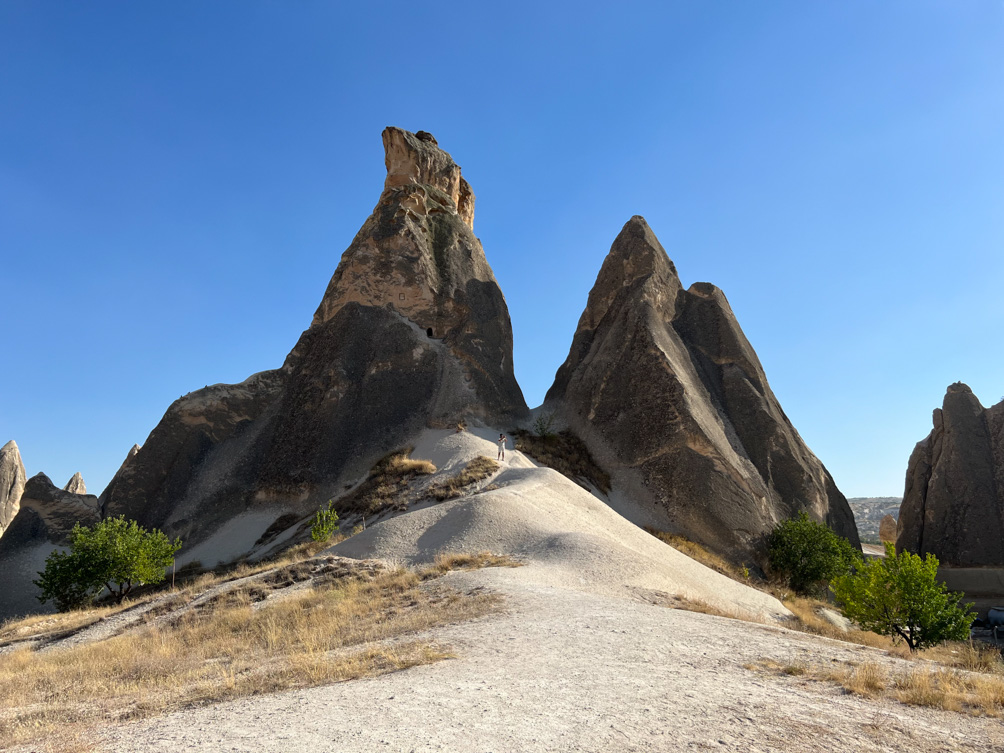
3. Pamukkale- white terraced travertines
Pammukale is a small town mainly known and visited for its white terraced travertine spa located beside the ancient city of Hierapolis. This city has a museum and a beautiful Roman theatre – not to be missed.
Closest Aiport: Dalaman Airport and İzmir Adnan Menderes Airport
Hotel Options: Hotel Sahin (superb view), Venus Hotel (mid-range), Melrose Viewpoint Hotel (budget)
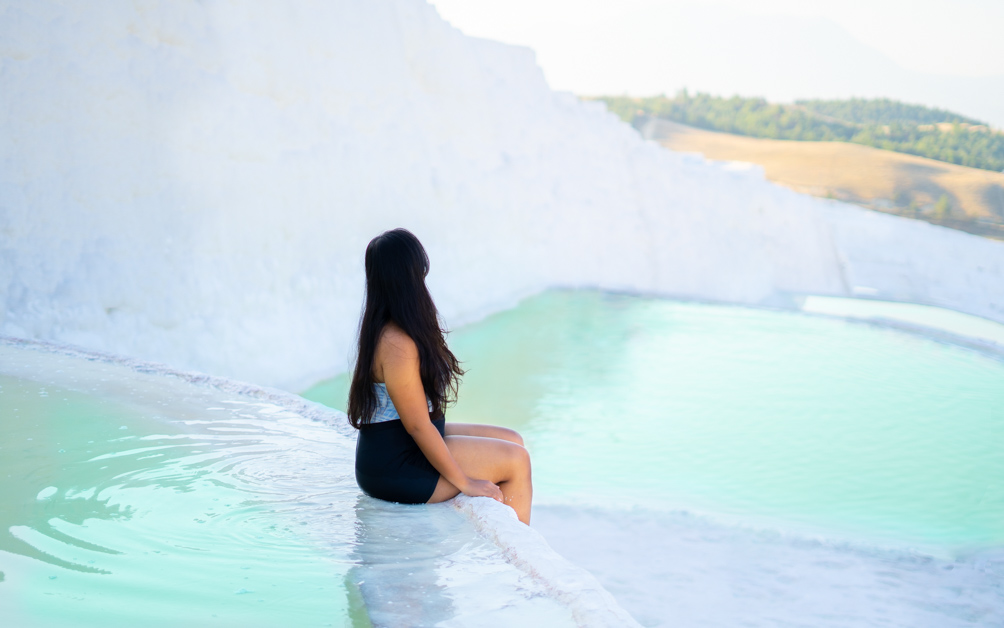
4. Selcuk (for Ephesus) – third largest Roman library
Ephesus is again an ancient Greco-Roman city. It has one of the finest examples of a Roman Library which was the third largest in the world in its day. Nearby, is also the site of one of the ancient wonders of the world – The Temple of Artemis.
These sites are all best visited by staying in the small town of Selcuk for one night.
Closest Airport: İzmir Adnan Menderes Airport
Hotel Options: Livia Hotel Ephesus (Adults Only) (semi-luxury), Celsus Boutique Hotel (mid-range), Hotel Urkmez (budget)
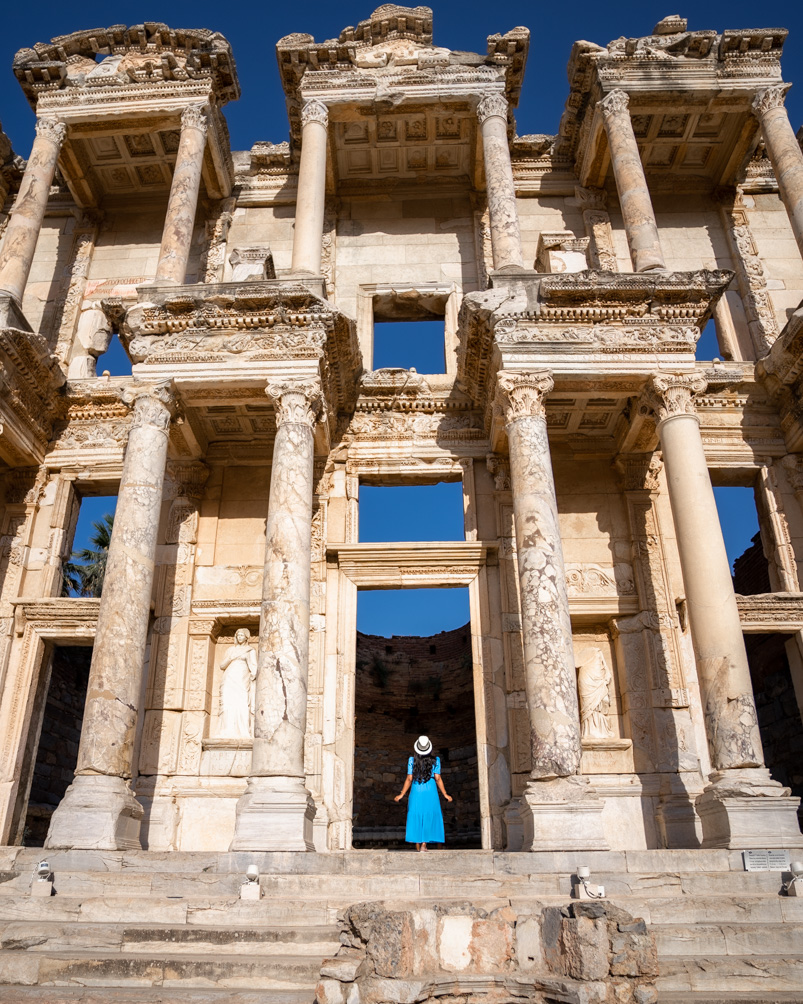
5. ALACATI – a cute beachside town with nightlife
Pronounced Aalaa-cha-tuh, the town was established by Greek workers and hence has all the Greek vibes with a Turkish Charm – think Greek stone houses, traditional and modern windmills, cobbled streets flanked by pink bougainvillaea. The town comes to life at night with its many superb bars and restaurants.
Closest Airport: İzmir Adnan Menderes Airport
Hotel Options: Biblos Resort Alaçatı (luxury), Sakin Ev (mid-range), Rebetiko Hotel (budget)
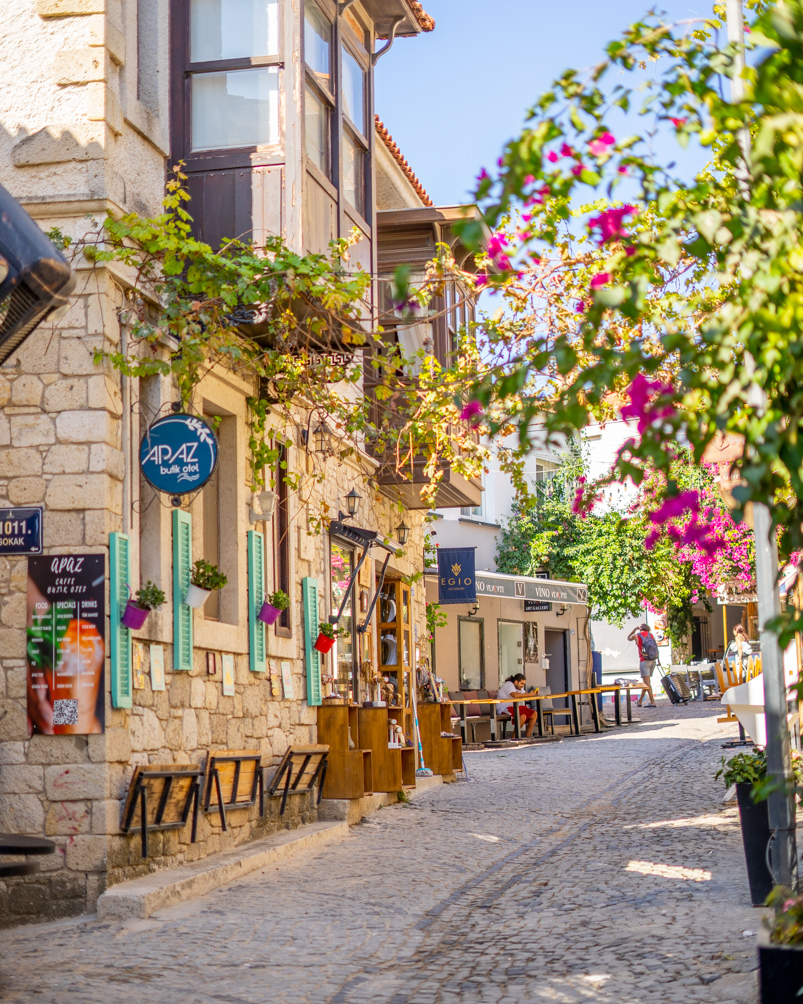
6. ANTALYA– beaches and history
Antalya is the largest city in southern Turkey and is known for its turquoise coast, ancient ruins and a waterfall by the sea. It is a hotspot for tourists – probably the most visited place after Istanbul and Cappadocia.
Closest Airport: Antalya Airport
Hotel Options: Casa Sur Antalya, Perge Hotels, White Garden Hotel
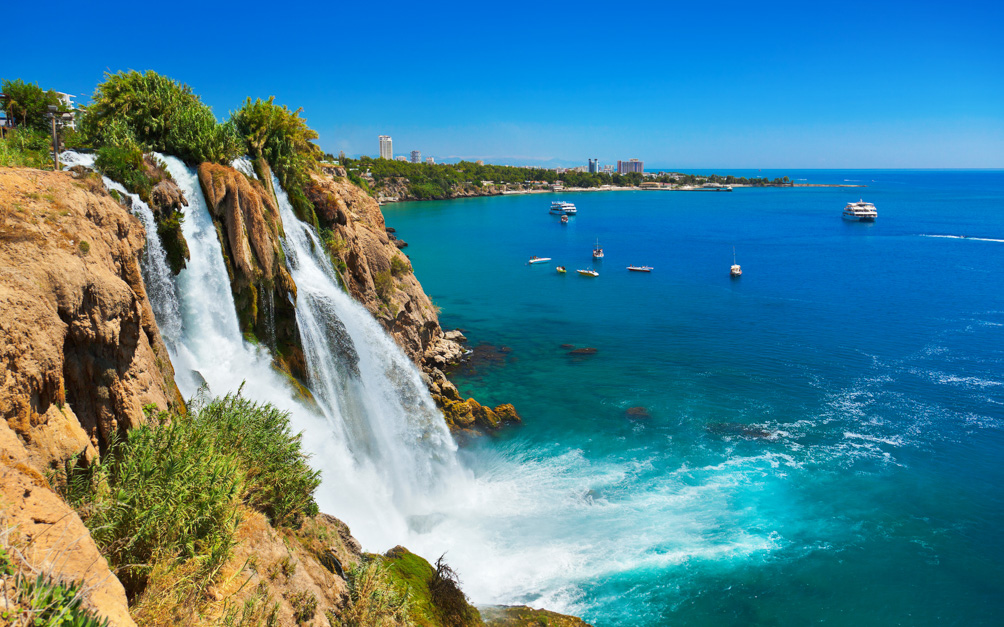
7. FETHIYE & OLUDENIZ: beaches and paragliding
Located about 4 hours south of Izmir and 3 hours west of Antalya, Fethiye is on the Turkish coast. Fethiye is surrounded by heritage sites, pristine beaches with azure waters and towering green hills. It’s also the start of the Lycian way- a 540 km hiking trail (you obviously don’t need to do the whole thing). Not only that, Oludeniz is considered to be one of the best places to paraglide in the world – the views are epic!
Closest Airport: Dalaman Airport
Hotel Options: Yacht Boheme Hotel, Sovalye Hotel, Heaven Bungalow Fethiye
If you have a car or are looking for a staycation then these hotels in Faralya (near Fethiye) are superb: Perdue Hotel and Nautical Hotel
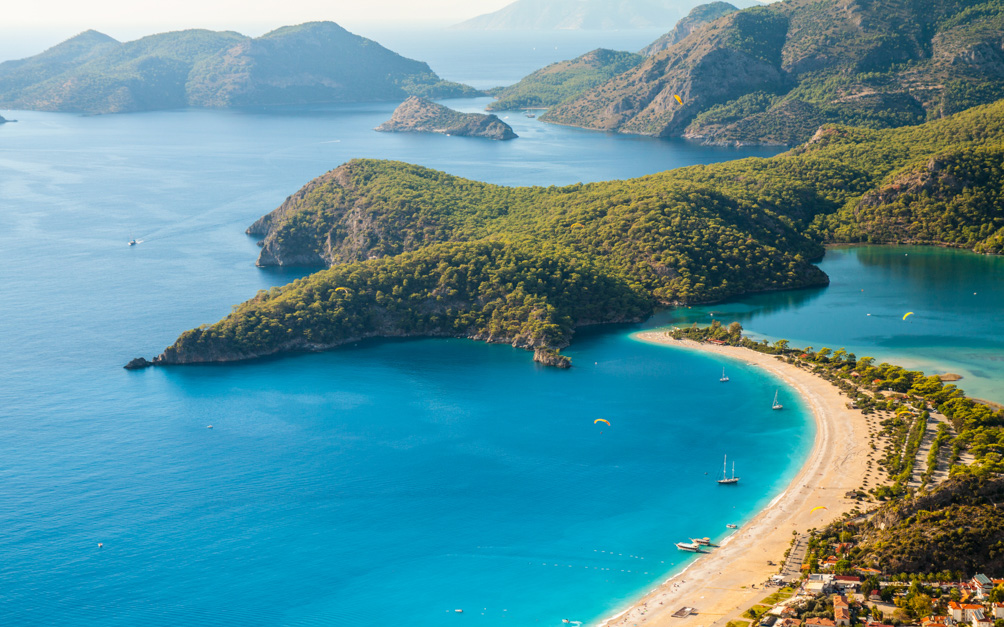
8. KAS- cute town, beaches, history
Kas is a charming seaside town between Antalya and Fethiye. It is a lot like Alacati, but with a lot more things to do. This was the town we really wanted to go to instead of Alacati but we need an extra day to make that possible without rushing it. Read more about Kas here.
Closest Airport: Antalya Airport and Dalaman Airport
Hotel Options: Hotel and Villa Kale Suites, Golden Rose Otelcilik, Payam Hotel
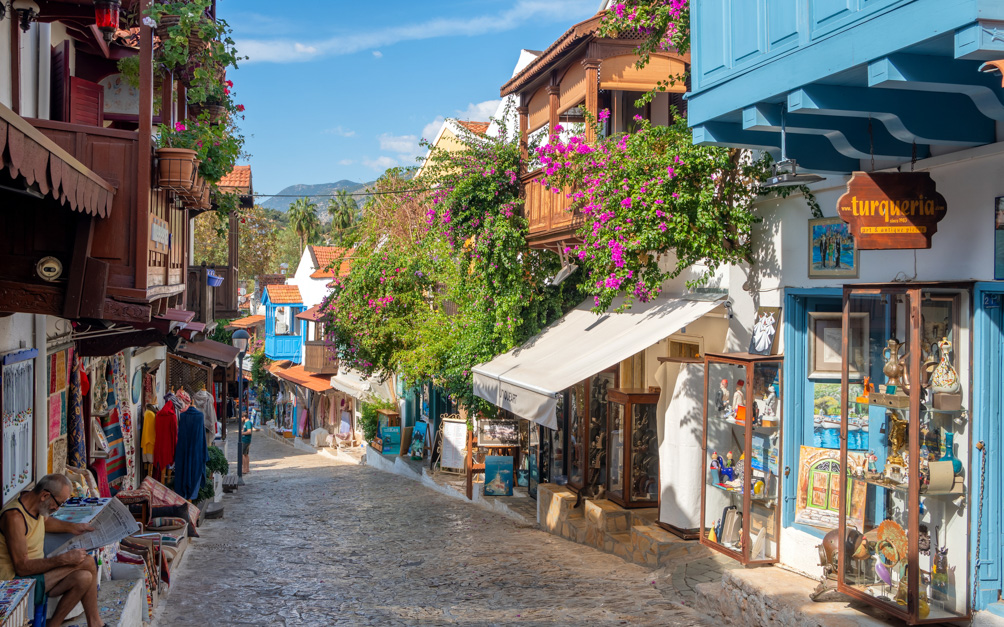
5. Turkiye Trip Itinerary
This is the itinerary we followed based on the flights we were getting at the time:
Best of Turkey – 10 days: Istanbul (2.5 days), Cappadocia (3 days), Alacati (2 days), Pamukkale and surrounds (1.5 days), Selcuk/Ephesus (1 day)
Read our detailed 10-day Turkey Itinerary
Your itinerary would depend on your interests but here are a few options you can use as a started point:
Turkey 7 days itinerary: Istanbul (2 days), Cappadocia (2.5 days), Choose one amongst any other place – Antalya / Kas / Fethiye and Oludeniz / Pammukale and Ephesus / Alacati
Alternate 10 days itinerary for Turkiye: Istanbul (3 days), Cappadocia (2 days), Antalya/Kas/Fethiye (3 days), Pamukkale and Ephesus (1 day)
Turkey 14 days itinerary: Istanbul (3 days), Cappadocia (3 days), Road trip starting from Cappadocia visiting Antalya (2 days), Kas (2 days), Oludeniz & Fethiye (2 days) heading over to Pamukkale (1 day) and Ephesus (1 day). End your road trip in Izmir. We would have lovvveed to follow this itinerary!
6. Turkiye tourist Visa
Before you plan a Turkiye trip, make sure you know what type of visa you’ll need. There are two types of visas – a sticker visa and an e-visa. The visa type you choose will depend on your purpose of visit, nationality and the documents you have. Check the general visa requirements of all countries here.
E-Visa
E-visa is a single-entry visa and is available for passport holders of 60 countries provided that you meet the required criteria which you can see once you start applying for the e-visa. You can apply for your e-visa any time before your travel because you get the e-visa in 10 minutes. We advice to apply at least a week prior in case of any unfortunate circumstances. The e-visa fee varies per your country and type of travel document.
For Indians
If you’re an Indian passport holder with a valid Schengen, USA, UK, Ireland visa or residence permit, then you can get an e-Visa which is valid for one month (in a 180-day period) via the website www.evisa.gov.tr, provided that you meet these conditions:
- The passport covers the period of stay in Turkey
- You can prove that you hold a return ticket, hotel reservation and at least $50 per day of stay.
- You are travelling for the purposes of tourism.
- You have a valid Supporting Document (Valid visa OR valid residence permit from one of the Schengen Countries, USA, UK or Ireland). E-visas are not accepted as supporting documents.
We have a US tourist visa so we applied for the e-visa through this link. The whole process took 5 minutes and we got the e-visa immediately after paying 43 USD (exactly INR 3522 was charged).
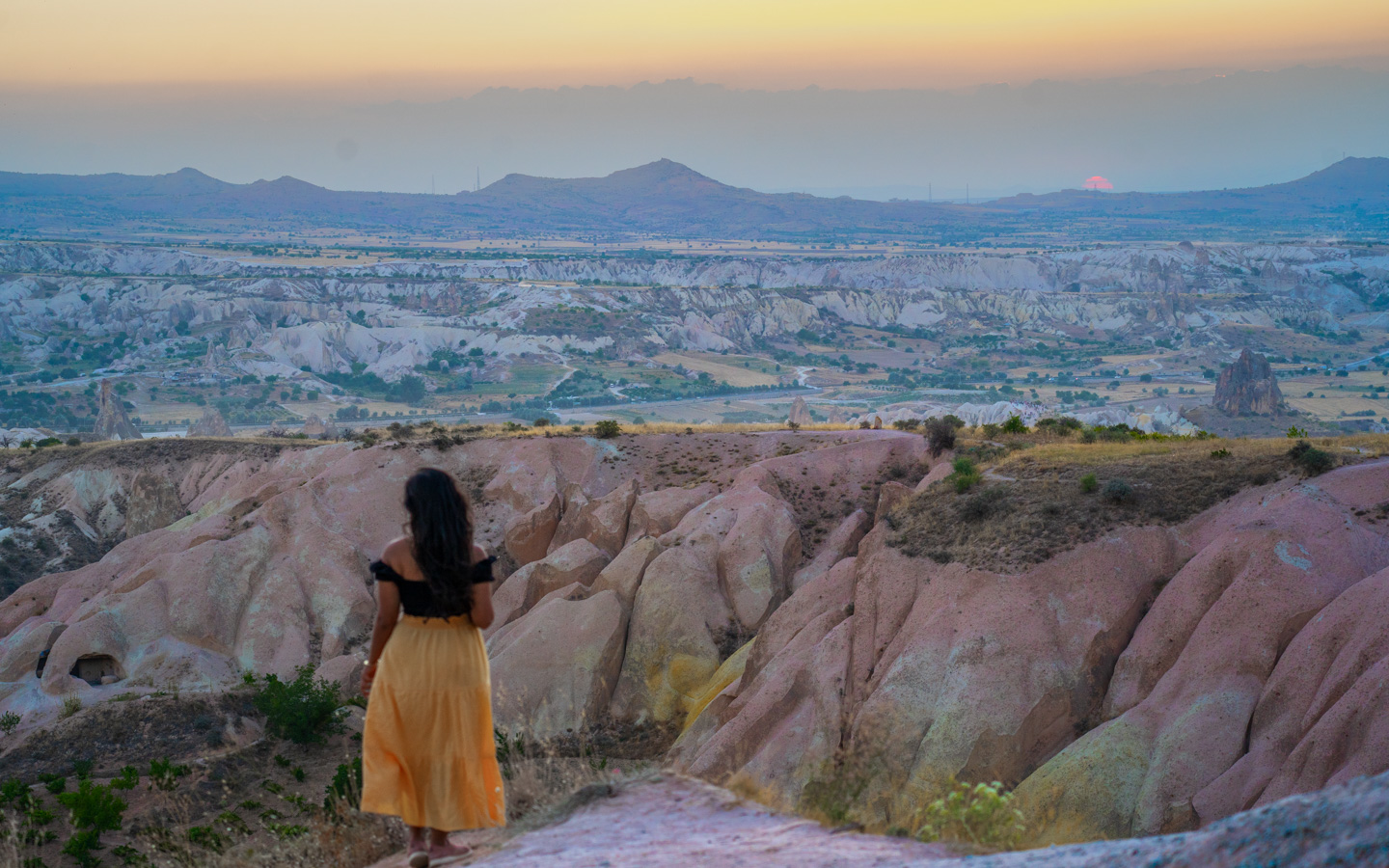
Sticker Visa
If you are not eligible for an e-visa, you will have to go through the sticker visa process which takes more time and money. But the good part is that you can apply 6 months before your trip. It is suggested you apply as early as possible. The maximum stay duration through a sticker visa is up to 90 days in a 180-day period and is available for single, double, or multiple entries.
A sticker visa, as the name suggests, is pasted on your passport. Therefore, you will be required to send your passport to the Turkish embassy. You need to get an appointment and visit the embassy to drop off and collect your passport. Please check this website to understand if you can fill out the pre-visa application directly or need to apply via an agency.
For Indians
Indian passport holders cannot fill out the pre-visa application directly and have to go through an authorized agency which is Gateway Globe. You have to fill out the application and undertaking forms, collect the listed documents and photos, book an appointment directly from their website, pay the visa fee, submit the form, and collect the visa.
A single-entry visa fee is about INR 4500, and a multiple-entry visa fee is INR 14,400. In addition, a service charge of INR 4,200 is payable over and above the visa fees.
If you have any queries, you can contact Gateway Global directly.
7. Is Turkey safe for travel?
All the places we have listed above are tourist hubs and safe to travel to. People are so nice and helpful and we never felt unsafe at any point in time. The country is also considered safe for solo travellers!
Border areas in general can be unsafe in many countries, but don’t worry you’ll probably not venture anywhere near it.
Other minor thefts and general security concerns are there in all countries. You can’t predict these things. Just stay vigilant no matter where you travel.
8. How to get around Turkey
Turkey is very well connected by flights, trains, busses and also has plenty rental car companies.
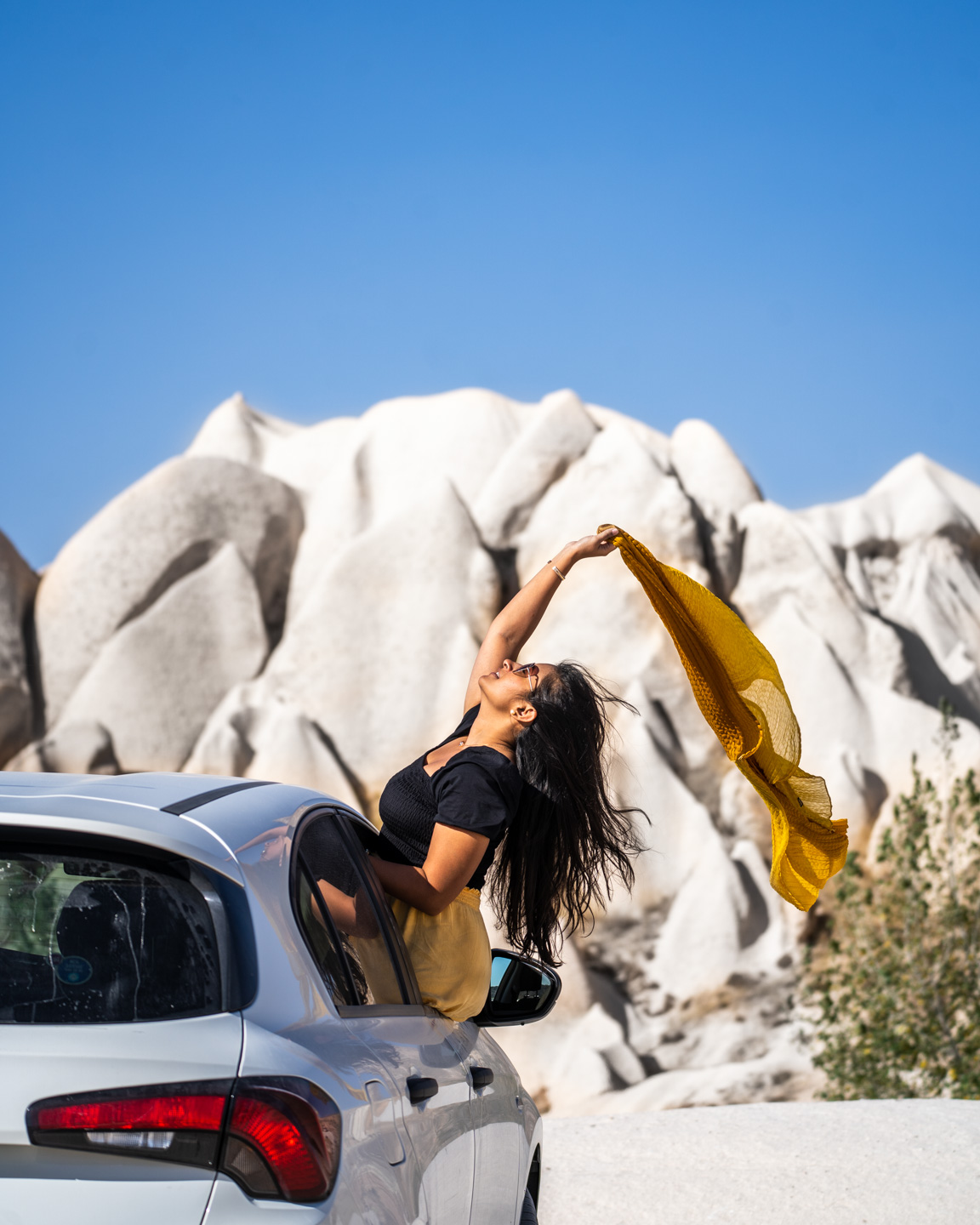
Flight: The easiest and most convenient way to get around is by flight. Nearly 50 cities in Turkey have active domestic or international airports but flights may not be direct for all routes and will go via Ankara or Istanbul. Domestic carriers include Pegasus and Turkish Airlines. Flights are relatively cheap, especially during the off-season. You can get them for as low as INR 2000!
Search for international and domestic flights
Bus: Bus travel is one of the most popular ways to travel around Turkiye as it is cheap and you can get to just about any corner of the country. Every city has its own intercity bus terminal with numerous companies. That being said, bus journeys can be long and night buses are not known to be very comfortable. To book a bus, you can go to the bus terminal on the day you want to travel, buy a ticket, and board the next bus. Or else pre-book below!
Search for busses
Train: Train travel is generally limited and slow in Turkey and not recommended though options are improving gradually. However, high-speed trains between Istanbul, Ankara, Konya and Eskisehir are great options!
Search for trains
Car: Turkey is a superb country for a road trip outside of the main cities. There are plenty of car hire services, the roads are fantastic, people follow traffic rules generally, and the views are ones to behold. Plus, it gets super easy to skip the crowded tours and have the freedom to explore small towns the way you wish. The best part is that you can get a car on your home driving license if it is in English and there is a photo of you on it – no International Driving Permit is needed in such a case.
Search for rental cars
9. How to get around the cities
Tram and Metro: Turkey’s larger cities like Istanbul, Izmir, Ankara, Bursa, Antalya, Konya, and Gaziantep– all have some kind of metro or tram system. We used the tram extensively in Istanbul – it was fast, easy to use, and helped avoid traffic.
Cab: You can hire a metered cab off the road or use Uber (available in Istanbul, Izmir, and Ankara) or Bitaksi (available in İstanbul, Ankara, İzmir, Kocaeli, Bursa, Antalya, Muğla, Adana, Mersin, Samsun and Kayseri) in major cities. Download these apps beforehand.
Ferry: In general, ferries are limited in Turkey. There are many routes in and around Istanbul serving the Marmara region and some routes extend to Bursa, Izmir and Canakkale.
Bus/Dolmus: Big cities are well connected by bus and smaller cities are generally well-served by dolmuş (minibus), though lack of signage can make this a tricky way to get around.
While big cities have fantastic public transport, small towns do not. You can take the Dolmus and busses in most towns but they’ll be limited. Honestly, I’d say that the best way to get around small towns would be by a rental car.
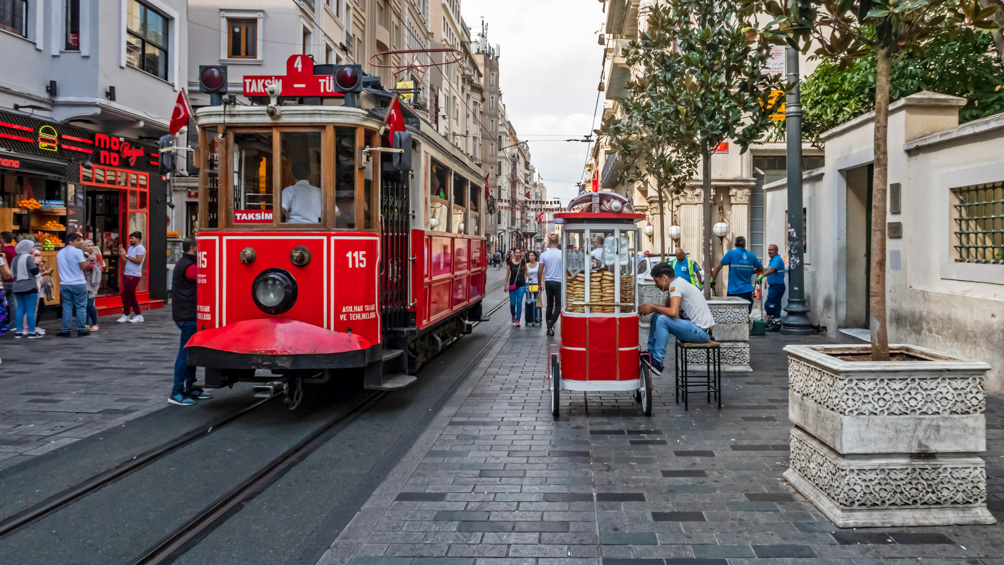
10. Renting a Car in Turkey
It is fairly easy to rent a car in Turkey. Here are two options:
- Pre-book it online: Try Discover Cars and Rental Cars. We used Avec to book our rental car in Izmir.
- Pre-book it through your hotel: We booked our hotels in Turkey via Booking.com which has the facility to chat with the hotel. So for Cappadocia, we just messaged our hotel about rental cars and they provided us with the best offer we were getting at the time.
Here are some things to know before renting a car in Turkiye.
- All foreign driving licenses are valid as long as they have a photo and are written in the Latin alphabet. You do not need an International Driving Permit in such a case.
- If your car pick up and drop locations are different, you will incur a surcharge. So consider this while making your itinerary.
- You will need a credit card to hire a car as there is usually a deposit amount put on hold on your card. Or it is directly deducted and later refunded.
- Unlike India, traffic is on the right side of the road and the steering is on the left of the car. This will take a day or two to get used to.
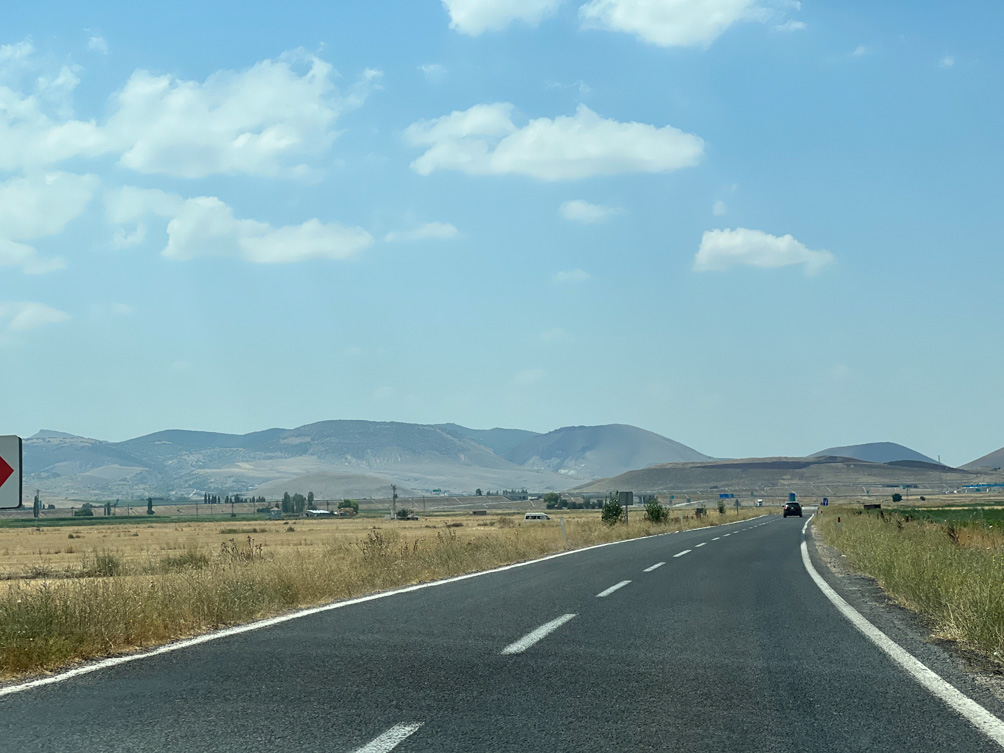
- You should be very confident about driving on slopes. The slopes in Cappadocia (Goreme mainly) had us going mental despite us being very comfortable driving on them.
- Car companies usually only let you hire a car if you’re at least 21 years old and have held your license for 1 year.
- If you’re between the ages of 21-25 you may have to incur a surcharge.
- Seat belts are mandatory and the use of a mobile phone while driving is prohibited, with the exception of a hands-free system.
- You will always need to have your driver’s licence, registration documents and insurance documents. The latter two are usually in the glove box.
- Tolls in Turkey are quite a few – we didn’t pay any tolls. However, ask your car rental company about the HGS toll system tag beforehand as having this will automate the toll payment process much like FASTag in India. This could be prepaid or postpaid.
- 0.05% is the max alcohol limit permitted which only applies if you are driving alone. So do not drink and drive at all!
11. What Currency to carry
The currency is the Turkish Lira denoted as TL or TRY and the exchange rate is 1 TL = 4.39 INR. See the current exchange rate.
A lot of tours accept Euros as well, especially in Cappadocia. You can pay by card in most places but you will definitely also need cash as well for public transport, street vendors, etc. It is best to keep Euros or USD and get it changed in Istanbul for Turkish Liras.
A lot of hotels and shops provide a 9-10% discount if you pay in cash. This is because the establishment will not have to pay a credit card fee to the bank. So, if you’re carrying cash, please ask if they will give a discount on cash payment.
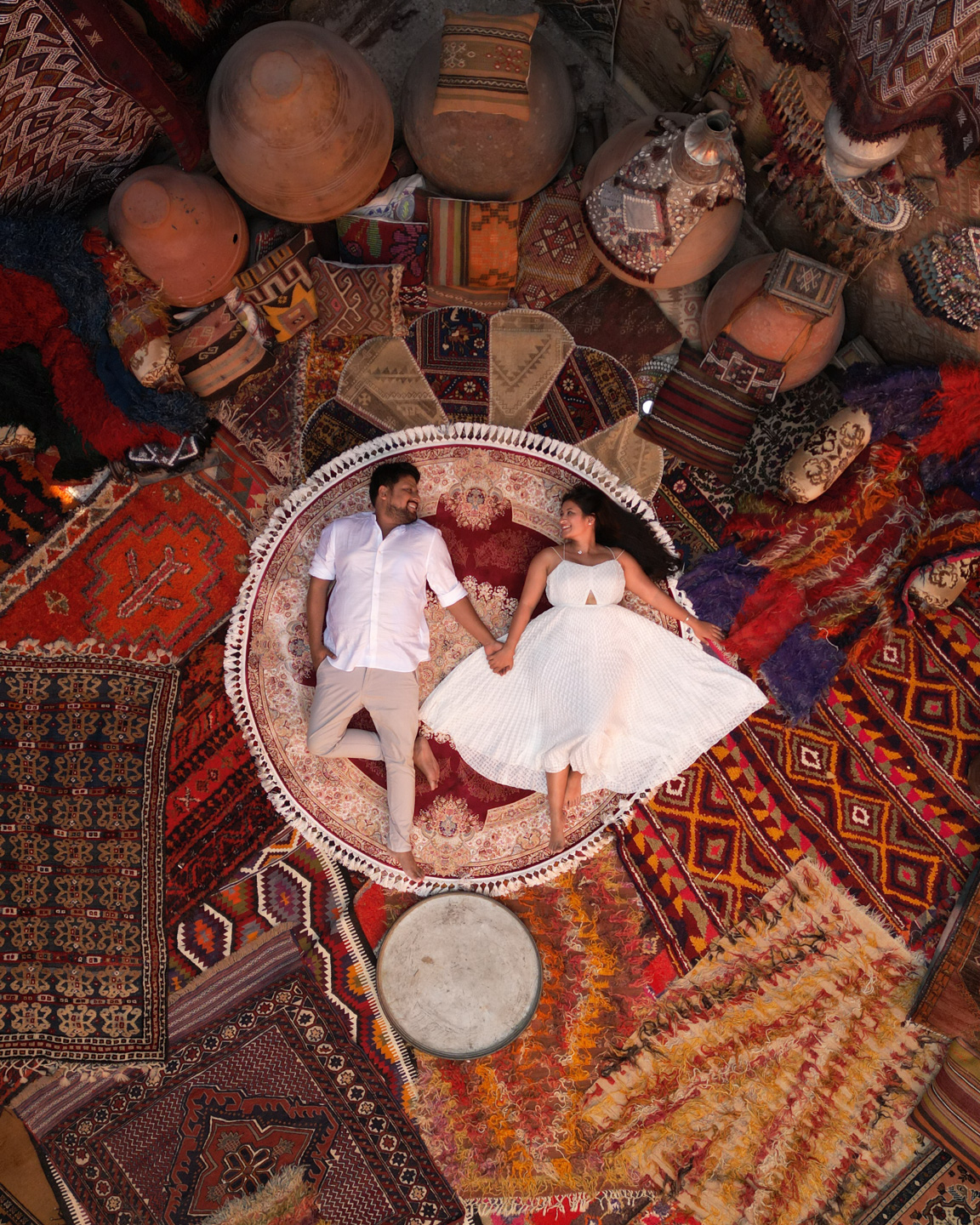
For Indians
You will not get the Turkish Lira easily in India. So you have two options:
- Carry Euros and exchange this for Liras in Istanbul.
- Carry a forex card and withdraw money through ATMs in Turkey.
We carried the Go Niyo Global Card which is a multi-forex card. We just had to load it with Indian Rupees and could withdraw in the local currency in 150+ countries with zero forex markup so it was perfect for Turkey. We paid with the card wherever possible and at other times we withdrew the max limit of TL 2000. Note that each time you withdraw from the ATM, Go Niyo charges you INR 118. Despite that, we found this option to be very very convenient.
Tip: Withdraw money from Ziraat ATMs as they were the only ATMs that didn’t charge us an extra withdrawal fee!
12. Get a local Sim
The wifi in Turkey can be dodgy. It is best to get a local sim to make things more convenient for you. You can buy a sim in the cities or at the airport.
The following networks are available in Turkey:
Vodafone
Türk Telekom.
Turkcell
Do compare prices and see what suits you best. We got Turkcell because it has the best reputation for 4G coverage.
13. Turkey Travel Budget
The cost of a trip to Turkey as to any other country depends on a lot of factors including:
- Season of travel: Peak season is more expensive than low season.
- How early you booked the trip (especially for travel during season time): Earlier can be cheaper
- Your style of travel: Taking public transport and eating local food would save you a lot of cash
- The destinations you visit: Some destinations like Cappadocia and Alacati are expensive
- The activties you do: Activties like hot air balloon rides and guided tours can be very expensive.
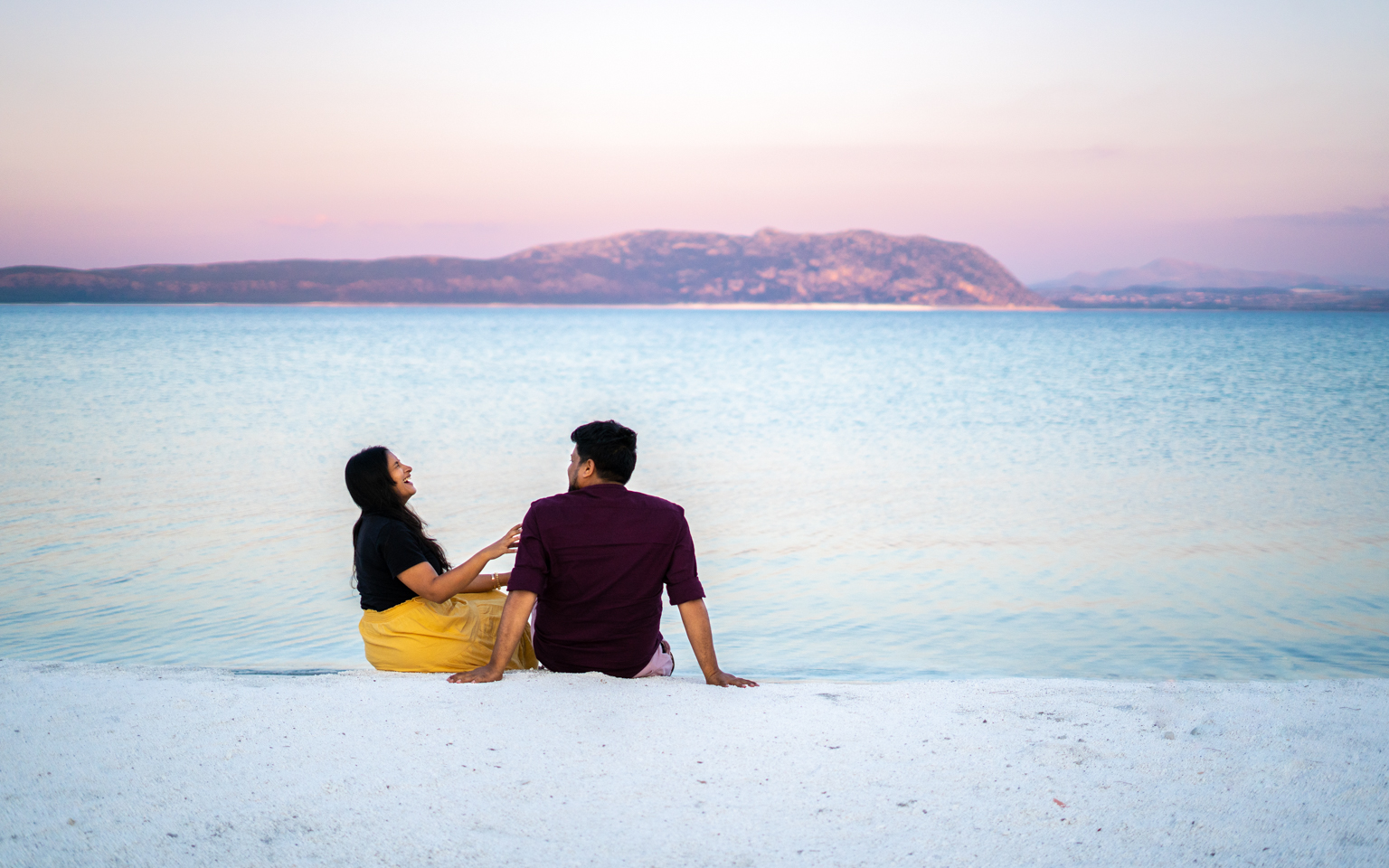
Mid-Range travel: We are mid-range travellers who like the convenience and are willing to spend on it but would still like the trip to not be very expensive. Our trip to turkey cost us about INR 2.9 lakhs for two people because we booked very late, travelled during season time, and hired a car instead of taking buses. The exact breakup is given below. If we’d done the same trip in some other months instead of (June- August) we could have probably done it in INR 2-2.25 L for two people.
Budget Travel: If you travel in the shoulder/low season, stay in budget hotels and hostels, don’t do a hot air balloon ride and take public transport you could do this trip for INR 70,000-80,000 per person including flights.
Category-wise costs in high season for a 12-day trip (10 days + 2 days travel)
| Category | Avg Cost (in INR) | Total Cost (in INR) | Notes/Tips |
| International Flights | 33,500 per person | 77,000 | International flight prices range from INR 30-50k |
| Domestic Flights | 5,000 per person per flight | 30,000 | In low season domestic flights can cost as low as INR 2-3K per person. |
| E-Visa | 3,522 per person | 7,044 | This was for an e-visa. Sticker visa costs will be higher! |
| Hotels | 5,600 (for two) | 68,000 | We mostly stayed in the cheaper category rooms. At the same price, you’ll get higher category rooms in shoulder/off-season |
| Car Rental | 2,700 (for car) | 19,000 | People have found superb deals on Discover Cars – as low as INR 10,000 for 10 days as well. |
| Petrol | 20 TL per litre | 8,000 | Petrol prices are comparable to that in India. |
| Attraction tickets | 9,100 per person | 9,800 | To save some money and skip lines, get the Turkey Museum Pass if you’re going for 10-12 days. If you’re going for more days or staying in one region for a long time, you might consider getting regional passes. |
| Hamam | 4,000 per person | 8,000 | A must-have spa experience in Istanbul’s historic hammams. Costs about Euro 40-50 no matter the season. |
| Hot Air Balloon | 15,000 | 30,000 | Hot air balloon rides usually start at 150 euros and can go as high as 350 euros |
| Food | 900 per meal | 25,500 | Food in Istanbul, Cappadocia, and Alacati is not cheap. You’ll find cheaper options in small towns like Selcuk, and Pamukkale and also in cities if you stay away from tourist hubs. Note that, two people might be able to share one dish since portions are large. We always ordered two mains and it was a bit much for us to finish. You might also get starters (small mezze like bread and dips), Cay and sometimes even dessert complimentary. |
| Misc Cost | 10,000 | Includes all cash transactions we made – tips, souvenirs, ice creams, lemonades, public transport, Uber, etc. | |
| Total cost for two | NA | 2,92,344 | In Turkish Liras this would be TL 66,600 |
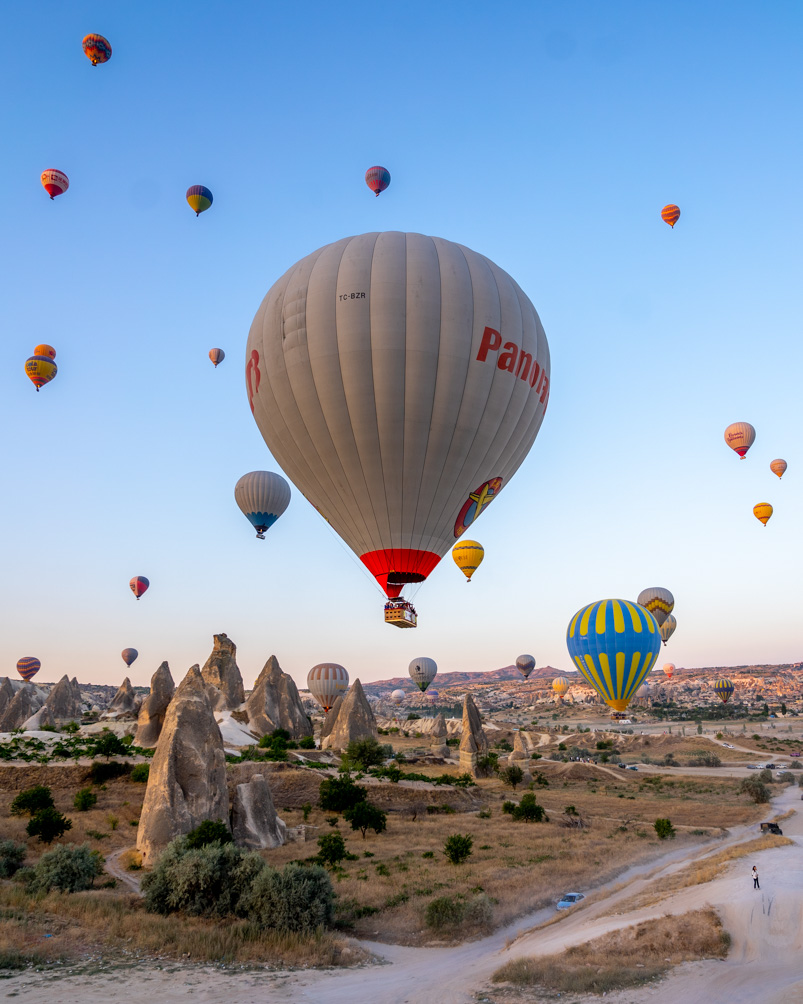

14. Tipping isn’t compulsory but always appreciated
Tips are generally low in Turkey. While tipping isn’t 100% necessary, it is always appreciated for good service.
In most cases, you cannot include the tip on a credit card charge so should be prepared to tip in cash directly to the person who has served you.
Cabs: Round up the fare. No tip is needed.
Porters in hotels: Tip 5-15 Liras per person.
Restaurants: 5% of the bill in small establishments and 10-15% of the bill in big ones.
Tour guides: 10 and 15 Turkish Lira if you feel it’s deserved.
Hamam: A tip of 10-15% of the bill is usually expected!
14. Food to try in Turkey
Turkish food has evolved over the centuries but is yet largely influenced by Ottoman cuisine (Eastern European, Central Asian, Middle Eastern)
Breakfast
- Turkish Breakfast: These consist of several small dishes including olives, different types of cheese, fresh bread, butter, jams and spreads, and black tea. You will be so full!
- Toast with White Cheese: A simple yet delicious toast with thick white cheese! Must-have.
- Menemen: Turkish version of scrambled eggs with tomato and peppers.
- Turkish Coffee: If you like strong coffee, you’ll love Turkish Coffee.
- Fresh Orange Juice and Lemonade: I am not kidding when I say, that these were much tastier than I’ve ever had before. They were naturally sweeter and less acidic – unlike the ones we have in India.
- Cay: Turkish black tea served in a Tulip Glass. This is had not only for breakfast but also after every meal and in between meals. It is truly the national drink of Turkiye.
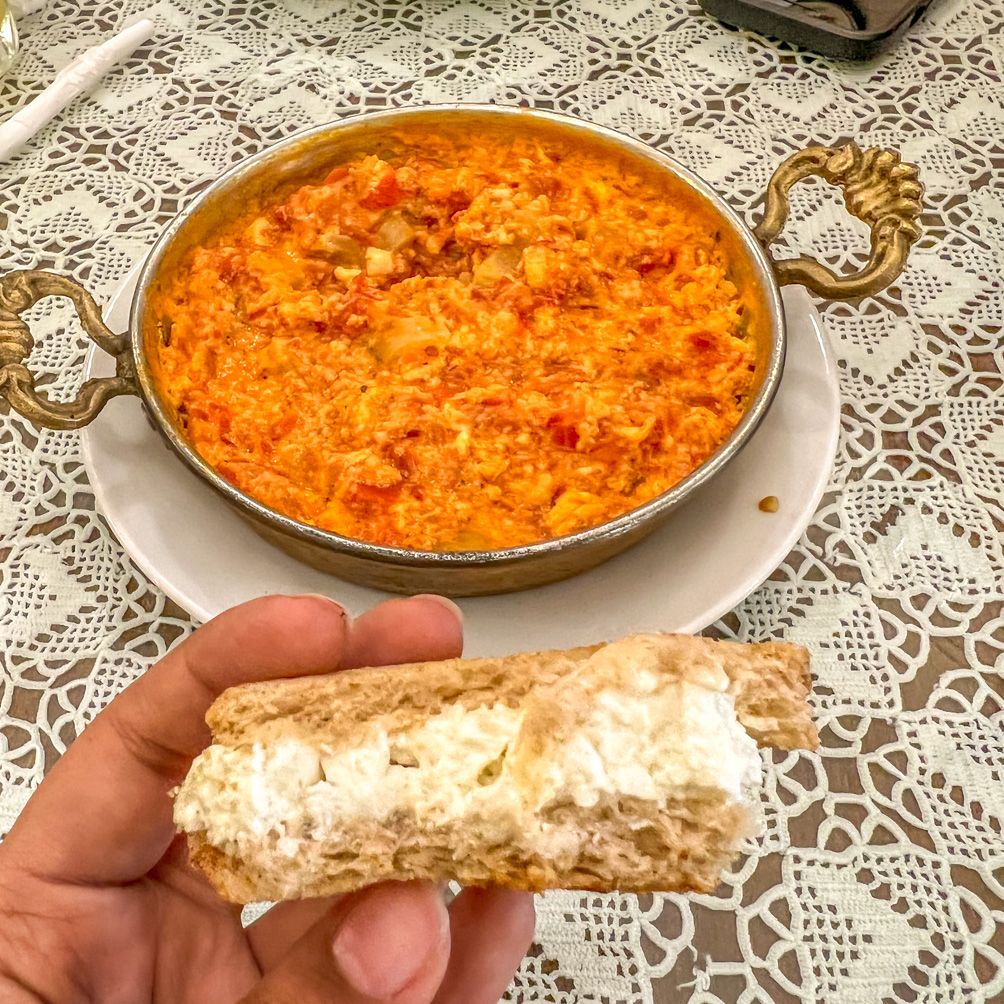
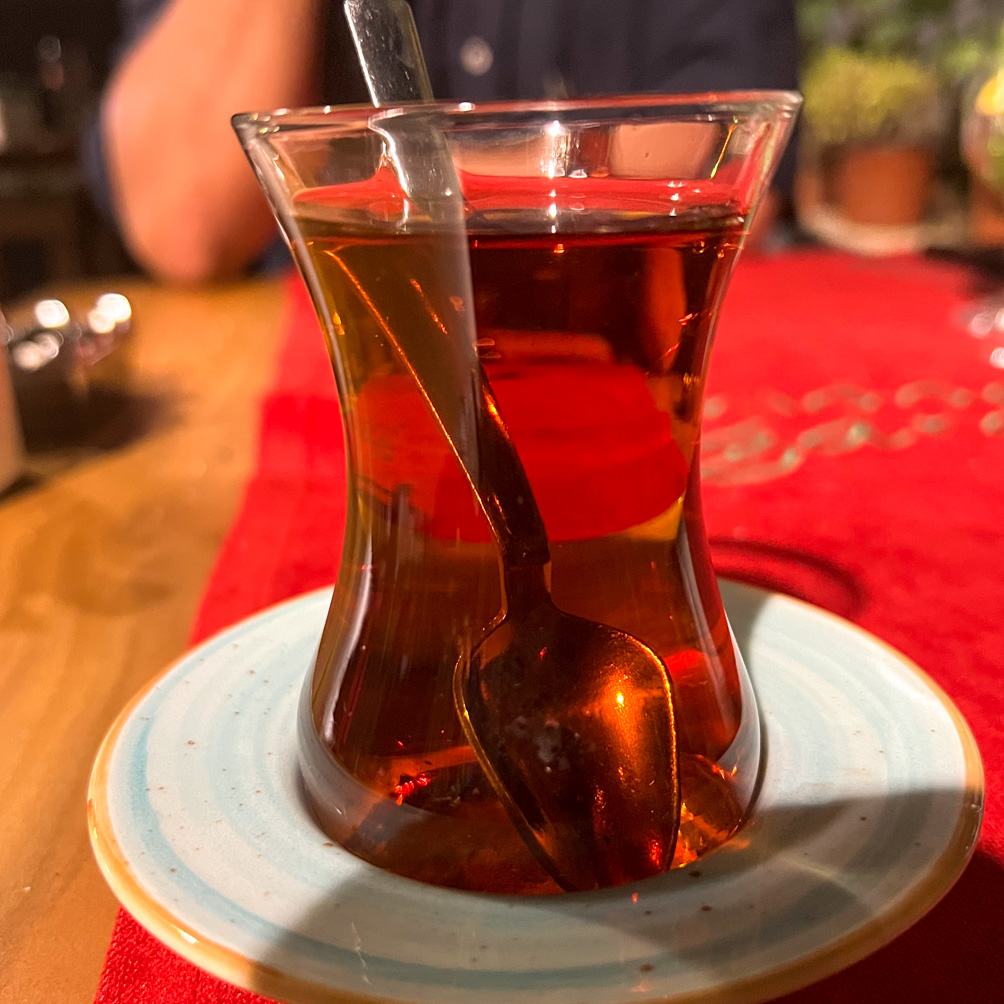
Lunch and Dinner
- Lentil Soup: A hearty thick soup made with red or orange lentils and spices.
- Pide: Pide is a boat-shaped Turkish Pizza made with a slightly thick dough and a wide range of fillings like meats, fresh vegetables, etc. Must-have!
- Mezze: The variety you get is insane and so delicious. Definitely try this in coastal areas.
- Gozleme: A Turkish paratha
- Manti: Turkish ravioli filled with ground meat or vegetables usually served with garlic yoghurt, spicy butter, and spicy tomato sauce.
- Borek: Borek is a flaky savoury pastry filled with things like potato, spinach, cheese, etc. We didn’t like it too much.
- Testi Kebab/ Pottery Kebab: Meat or vegetables cooked for hours in an earthen pot. Try this in Cappadocia!
- Lahmacun: Crispy flatbread spread with seasoned minced meat. We could not find a veg version of this.
- Doner: Pita bread spread with shaved meat cooked on a rotating spit, vegetables, and spices, folded like a sandwich.
- Sis Kebab: Skewered pieces of meat cooked on hot charcoal.
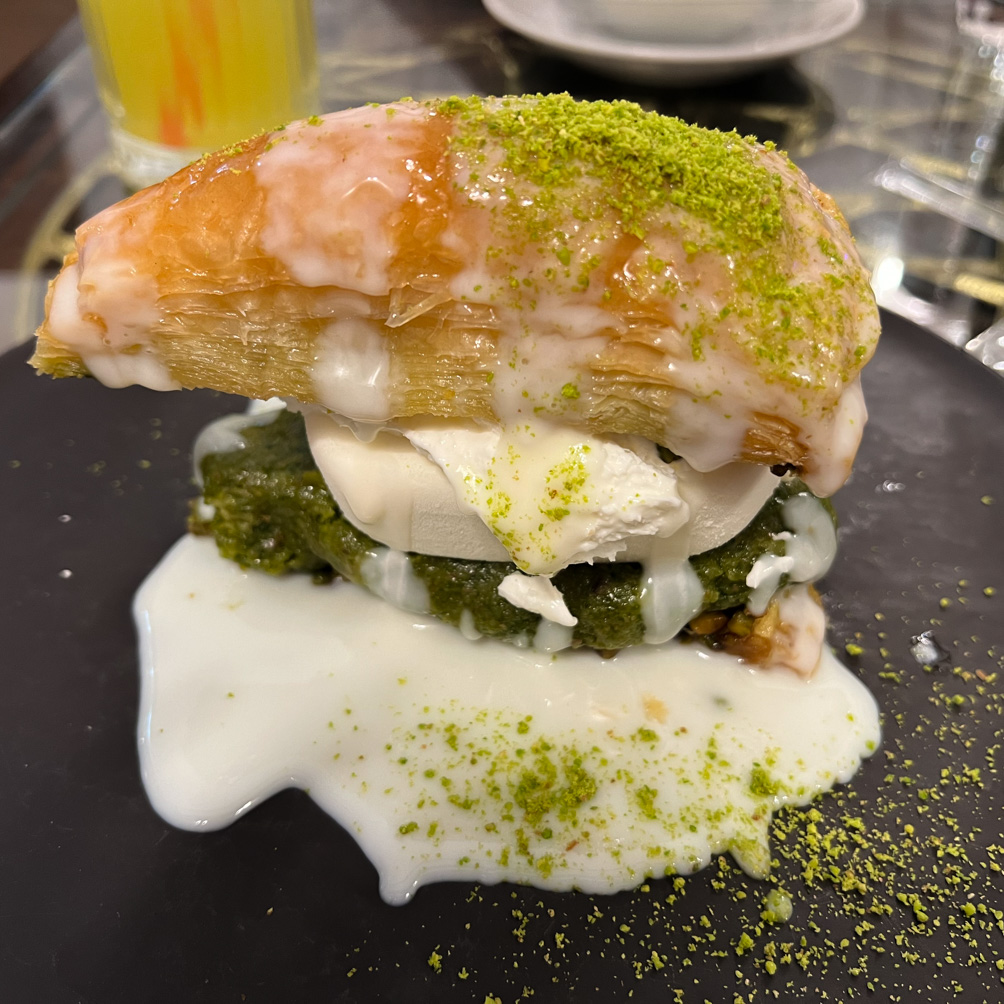
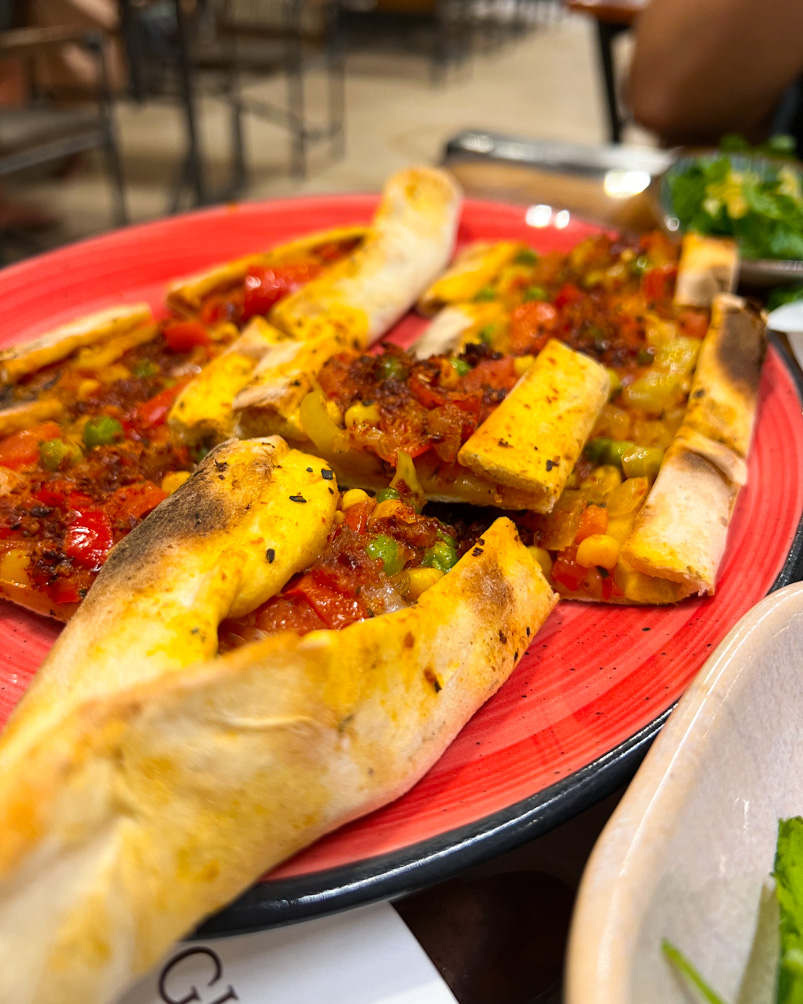
Dessert
- Helve: Turkish Halwa. It is drier compared to what we make in India but equally tasty.
- Baklava: A rich syrupy pastry dessert traditionally filled with chopped nuts. Have this with fresh cream!
- Kunefe: Shredded pastry soaked in traditional syrup and layered with special cheese, nuts, or clotted cream.
If you’re a foodie and would like to learn about Turkish Cuisine from a local – go for this food tour.
If you’re a foodie who also loves to cook – go for this cooking class.
16. language barrier: most people don’t speak English
Most people in Turkey speak only Turkish. People in the tourism industry like hotel owners and guides will know English but the workers in these places may not. Keep the Google Translate App downloaded and also download the Turkish language for offline use. Learn to use the app beforehand!
Since Turkish is written in Latin Script like English, you will learn a lot of words throughout your time in Turkey. But till then, it would help to know some words in Turkish!
17. Do not discuss politics
Try not to discuss politics in a public place as the locals in Turkey often have strong political views and can get offended. Also, you must know that Turkish people dearly love and respect the first President of Turkey, Mustafa Kemal Ataturk, so can be sensitive when discussing him.
18. What to wear
Turkish cities are very modern and people do not really limit themselves in what they wear. Even in coastal areas, you can mostly wear what you wish. Women can wear strappy dresses and shorts if they’d like (we saw so many people wear these).
However, the population in small towns can be conservative – just like it is in India. On the days you’re visiting mosques, women should carry a scarf to cover the head and both men and women should wear clothes are cover both the shoulders and knees.
As a general rule, I either wore a strappy dress/top that was long enough to cover my knees or a half/full sleeve dress that left my knees bare.
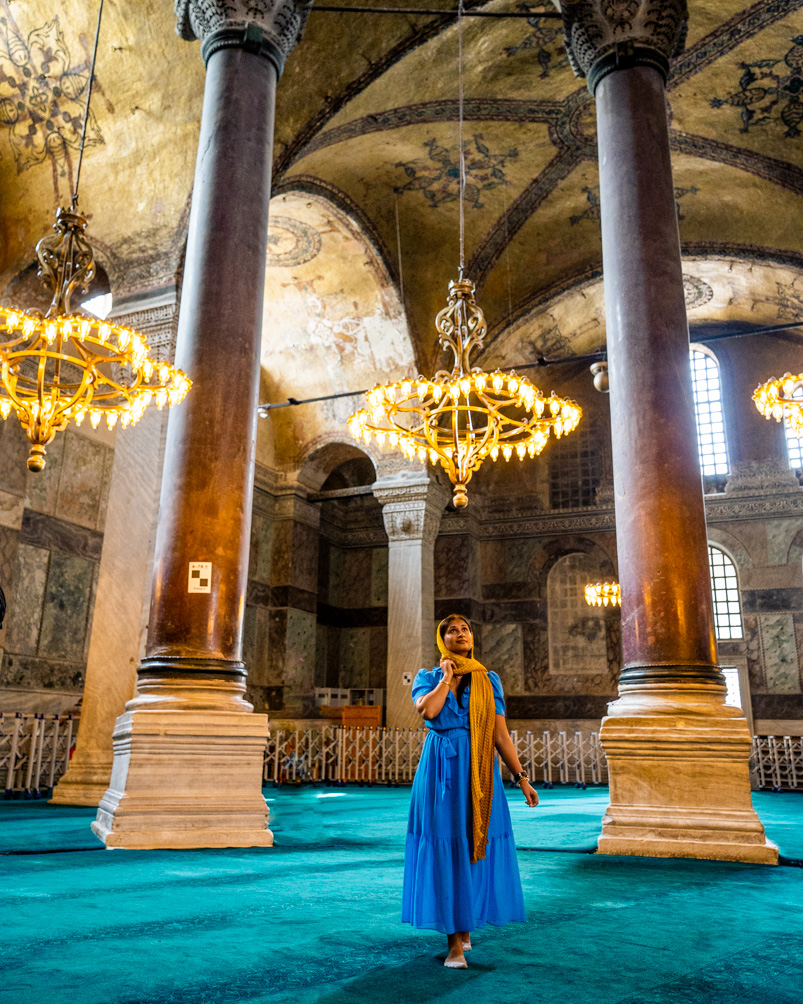
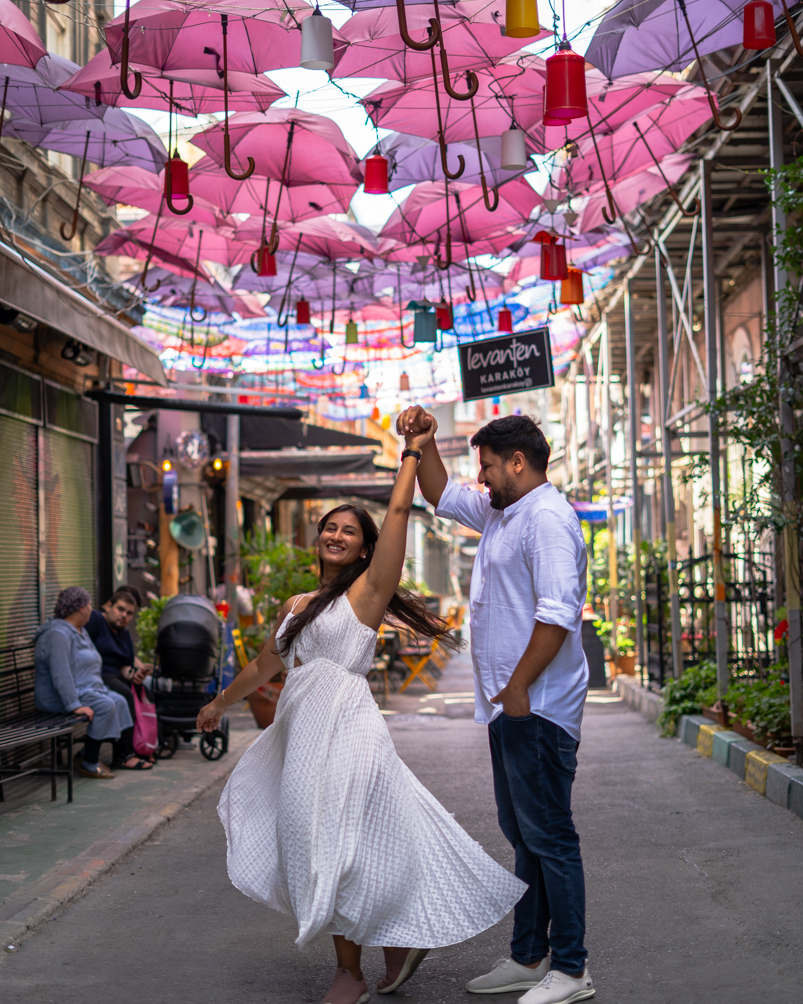
19. What to pack when travelling to turkey
1. International Travel Adaptor: There are two plug types used in Turkiye – Type C and F – and operate on a 230V supply voltage and 50Hz. Best to have an international travel adaptor.

2. Swimsuit: For the many beaches and pools.
3. Scarf: To cover your head in religious places.
4. Hat: If you’re travelling in the summer, you will definitely need one. I didn’t understand the intensity of the Turkish sun till I spent a few days there without a hat!
5. Sunglasses: Same as the hat, you simply can’t go without this.
6. Sunscreen: Best to buy a reef-safe skin-safe sunscreen! Please only buy one that contains non-nano Zinc Oxide and/or Titanium Dioxide. These are very tough to find in India but here is a great option. It has a silicon texture and can be very slightly greasy but it hasn’t been a deal breaker despite my oily skin. Do try it and decide for yourself. If you know of any other such sunscreens, tell us in the comments section. Most chemical sunscreens contain very harmful ingredients like Oxybenzone, Octinoxate, Avobenzone, and Octocrylene which are oftem disguised by other more complex scientific names. Do check this article for more info on harmful ingredients in sunscreen.
7. Sweater/jacket: If you’re travelling in the summer and going to Cappadocia for a hot air balloon ride or to chase them in the valleys, you will need a light jacket because Cappadocia is very cold in the mornings. For winters, carry at least two layers (jacket+sweater) because it gets very very cold in Turkey.
8. Comfortable shoes: You will be walking a lot. There are a lot of slopes in Turkey too. It is best to get comfortable walking shoes with no heels. We usually take with us our Neeman’s, Skechers, or Birkenstocks.
9. Insta 360 X3 or a Long Selfie Stick: For a shot of yourself on the hot air balloon – you’ll need either of these two. I totally wished I had the Insta 360 X3 because the invisible selfie stick makes it look like you are taking a super wide drone shot without actually flying a drone. Instead, I carried a long selfie stick to attach to my phone, but lost the selfie stick before it achieved its purpose.

10. Basic Toiletries: Hotel toiletries, if you’re not staying at established 5-star chain hotels, are quite shady looking. I highly recommend you fill such travel bottles with your own shower gel, shampoo, conditioner and lotion for this trip.
11. A wet bag: You’ll need a plastic bag or a wet bag like this to keep your wet swimsuits. we were super thankful we had this in Pamukkale.
12. A waterproof mobile cover or a Go Pro for all your water shots.
20. Books to Read Before Visiting Turkey
Turkey is so rich in history. I highly recommend that you read at least one book on Turkey so that you make the most of your trip. Here are some options:
Istanbul: City of Majesty at the Crossroads of the World (Thomas F. Madden): This is the complete history of Istanbul that starts right at the beginning with Byzantion and Byzantion Constantinople ending with Ottoman Constantinople and modern-day Istanbul.
This is the book I read before going and it really made Istanbul’s sights come to life during my visit.
Ataturk: The Biography of the Founder of Modern Turkey (Andrew Mango): This is the biography of the founder of modern-day Turkey. You’ll read about the fall of the Ottoman Empire up to the rise of the Republic all while learning about Ataturk.
Istanbul: Memories and the City (Orhan Pamuk). The famous novelist’s portrait of Istanbul as well as a portrait of his own life within the city.
READ NEXT>>>>>>> The Ultimate 10-Day Turkey Itinerary
We earn a small commission when you make a purchase through the recommendation links given in this blog post at no extra cost to you.

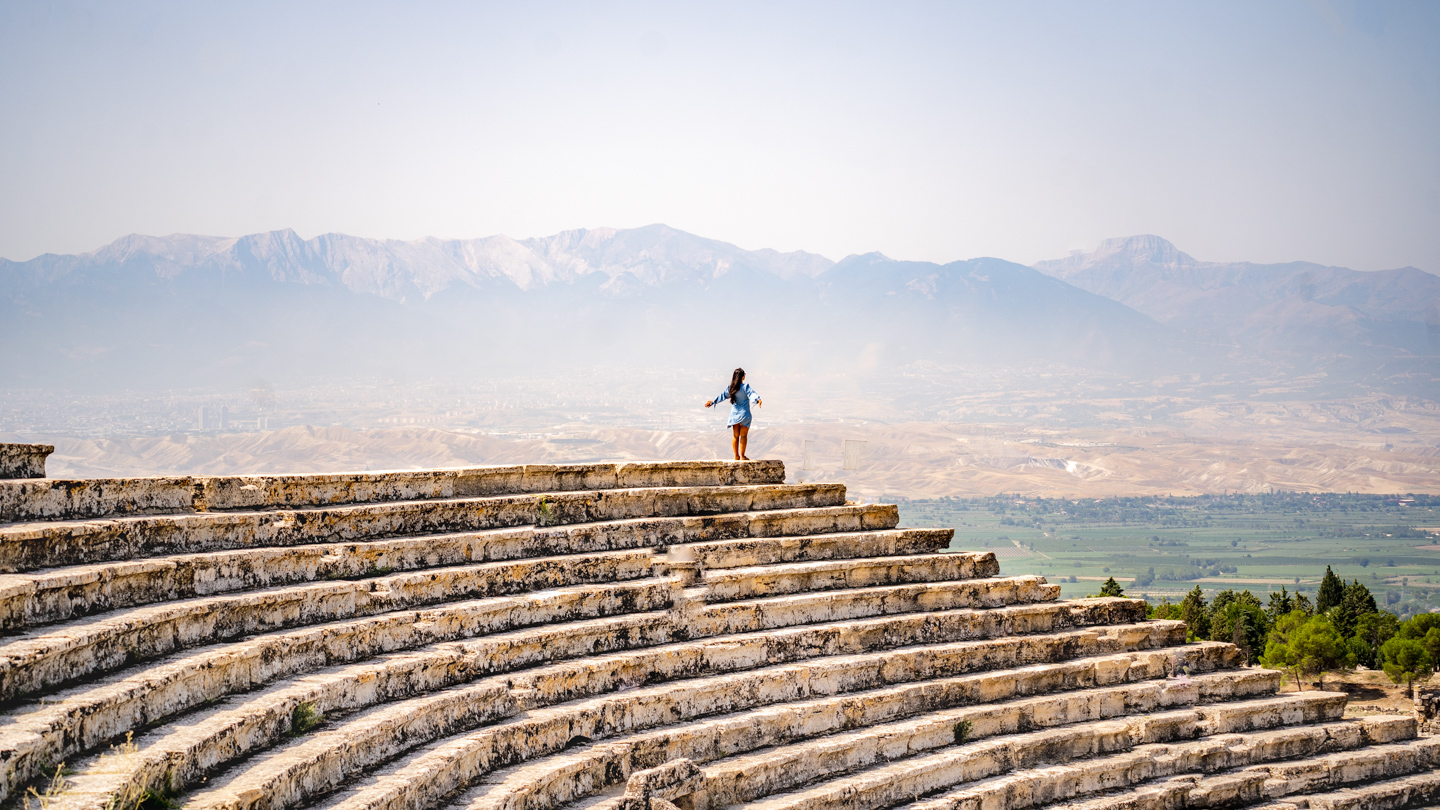



While you have suggested hamam in Istanbul, do you have any suggestions for the same in Cappadocia?
Hey Samridihi, unfortunately, we don’t have recommendations for Hammams in Cappadocia. The reason why a Hamam is suggested in Istanbul is that Istanbul has historic hammams that are over 300 years old or more making it one of the best places in Turkiye to experience it.